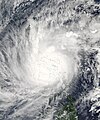File:Durian 2006-11-30 0500Z.jpg
Appearance

Size of this preview: 457 × 599 pixels. Other resolutions: 183 × 240 pixels | 366 × 480 pixels | 586 × 768 pixels | 781 × 1,024 pixels | 1,563 × 2,048 pixels | 5,800 × 7,600 pixels.
Original file (5,800 × 7,600 pixels, file size: 6.18 MB, MIME type: image/jpeg)
File history
Click on a date/time to view the file as it appeared at that time.
| Date/Time | Thumbnail | Dimensions | User | Comment | |
|---|---|---|---|---|---|
| current | 01:29, 11 December 2006 |  | 5,800 × 7,600 (6.18 MB) | Coredesat | |
| 01:25, 11 December 2006 |  | 5,000 × 6,500 (11.94 MB) | Coredesat | ||
| 01:11, 11 December 2006 |  | 5,000 × 6,000 (5.12 MB) | Coredesat | {{Information |Description=NASA MODIS image of Typhoon Durian over the Bicol Region of the Philippines, on November 30, 2006. |Source=[http://earthobservatory.nasa.gov/NaturalHazards/shownh.php3?img_id=13996 NASA Ea |
File usage
The following 4 pages use this file:
Global file usage
The following other wikis use this file:
- Usage on de.wikipedia.org
- Usage on fr.wikipedia.org
- Usage on nl.wikipedia.org
- Usage on sv.wikipedia.org
- Usage on th.wikipedia.org
- Usage on tl.wikipedia.org


